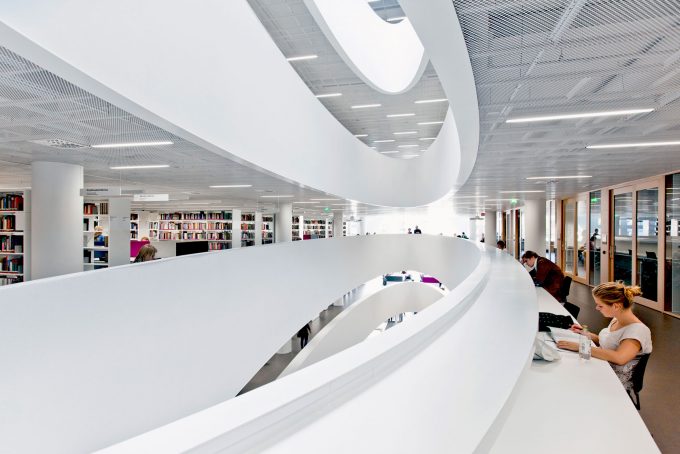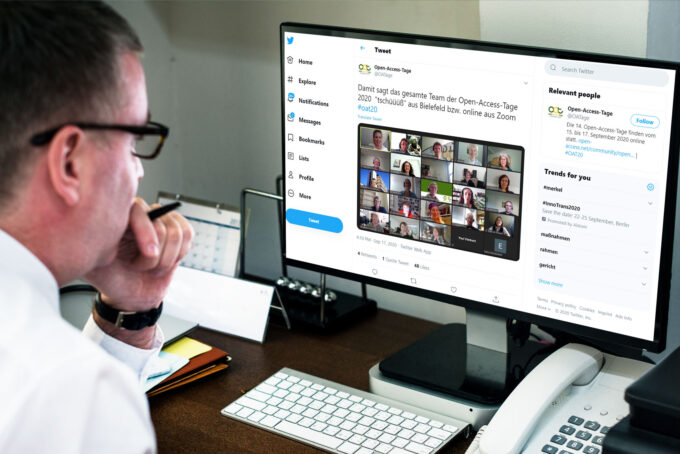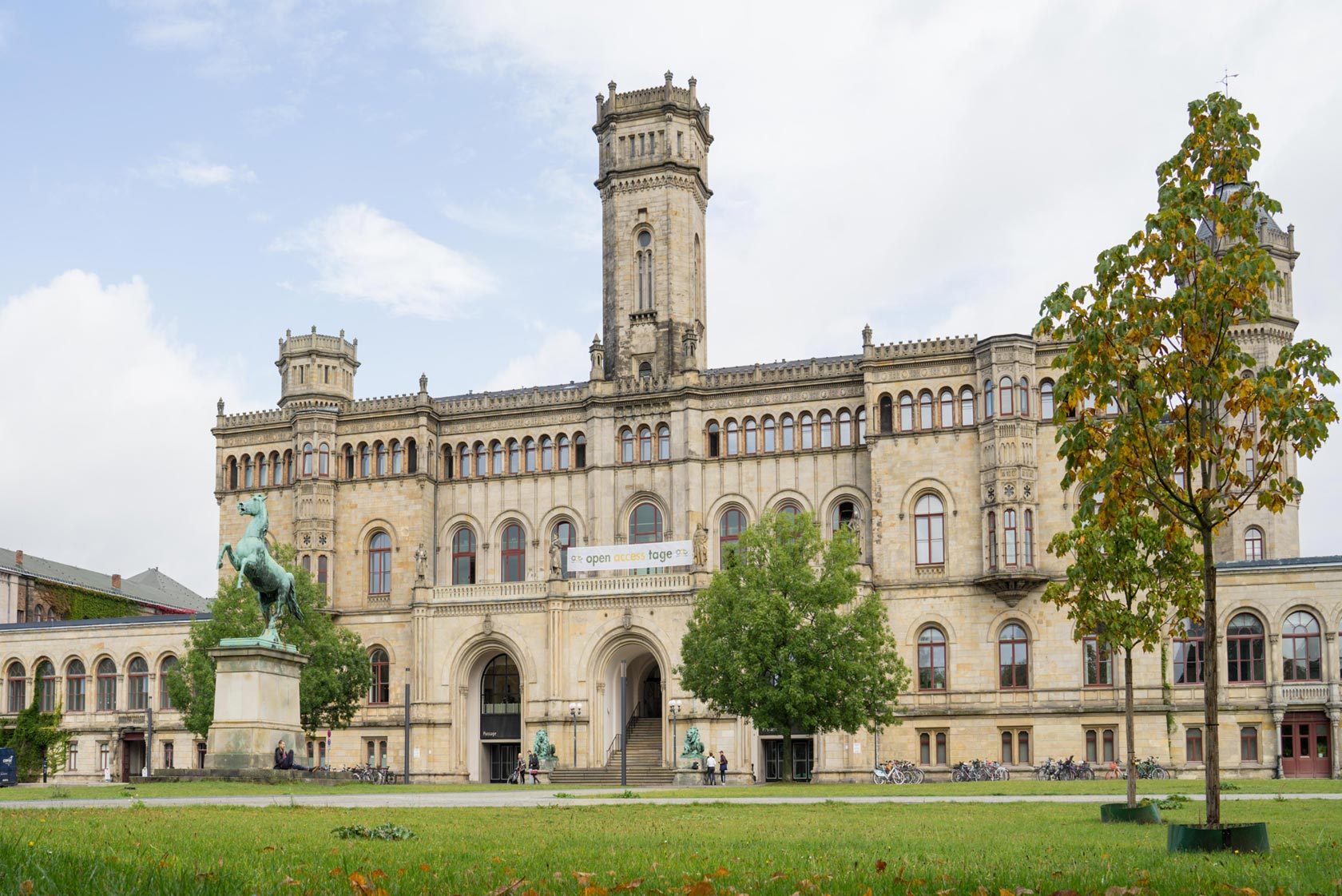
2019 Open Access Days: Business Models and Their Financial Impacts for Open Access Transformation
At the 2019 Open Access Days, business models for open access transformation were one area of focus. Connected with this were questions of the extent to which previous business models hinder transformation and which alternative business models exist. Open educational resources, their fields of application and previous barriers in practice were also in focus.
by Laura Bickel, Nicole Clasen and Ralf Flohr
The 2019 Open Access Days (link in German language) (Twitter) took place in Hannover between 30 September and 2 October 2019. We report on some key topics relating to the financing of open access transformation and to open educational resources.
What disadvantages do “author pays” business models have in open access transformation?
With the topic of “business models”, session 3 was dedicated to one of the key topics of the 2019 Open Access Days. Alternative business models were presented and discussed against the backdrop of DEAL contracts and the “author pays” model (APC model), which continues to be a central point. The APC model receives lots of criticism because it continues to lead to price increases and is not accepted in some disciplines. Thus, there are now still very few renowned open access journals with APCs in the humanities and social sciences. The DEAL contracts are also expected to lead to a transformation of journals towards open access only in very few cases (Flipping). Unless other countries with high publication figures conclude comprehensive transformation agreements, most of the journals from major publishers will remain subscription-based for the foreseeable future.
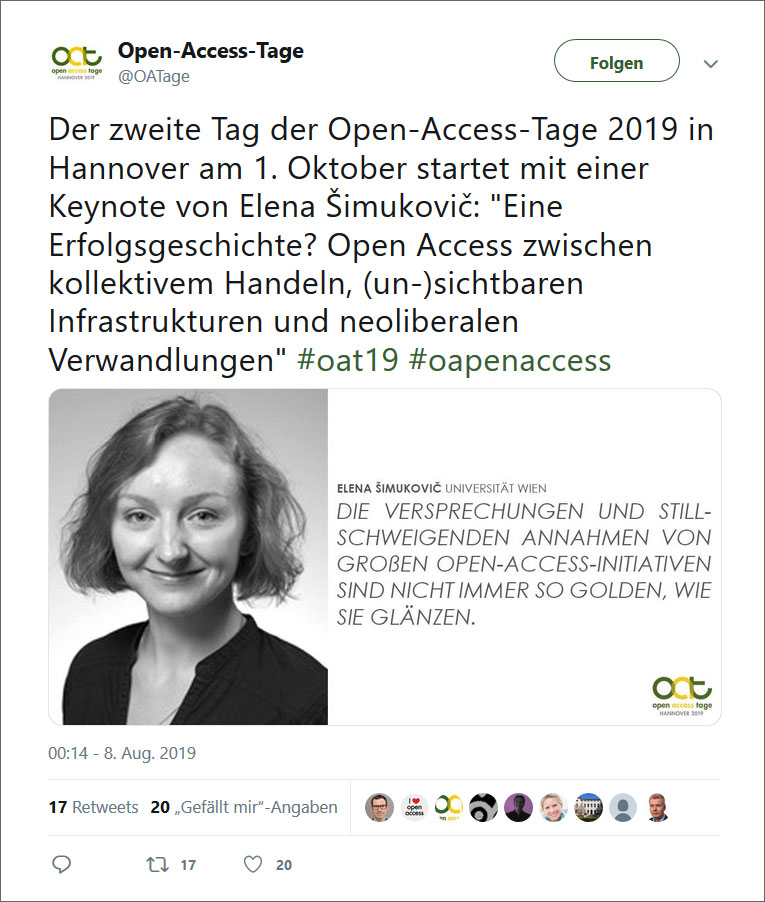
Criticism of the transformation agreements was also expressed elsewhere during the conference, in particular in the keynote speech “A success story? Open Access between collective action, (un)visible infrastructures and neoliberal transformations” (link in German language, “Eine Erfolgsgeschichte? Open Access zwischen kollektivem Handeln, (un-)sichtbaren Infrastrukturen und neoliberalen Verwandlungen”) by Elena Šimukovič. She emphasised, for example, that existing power relations and dependencies between major publishers and research institutes will be consolidated. In addition, organisations with high publication figures will disproportionately bear the costs in future as a result of the orientation of the financing to the number of publications. The fair distribution of these costs is an issue that is currently being debated intensively (link in German language).
Alternative business models for open access transformation
Against this backdrop, Anja Oberländer and Lena Dreher provided an overview of alternative business models (link in German language). Institutional financing models were presented, in which journals are often run by research institutes and specialist companies on the basis of the open journal system. Furthermore, crowdfunding and consortium financing play a more significant role here. APCs are not collected with these models or taken over by the financing organisations. In terms of crowdfunding models, “Subscribe to Open” and Knowledge Unlatched were presented.
The “subscribe to open” initiative, to which reference was already made in the opening keynote “Daring to Dream of Universal Open Access” by John Willinsky, is a model which is used for existing journal subscriptions by libraries:
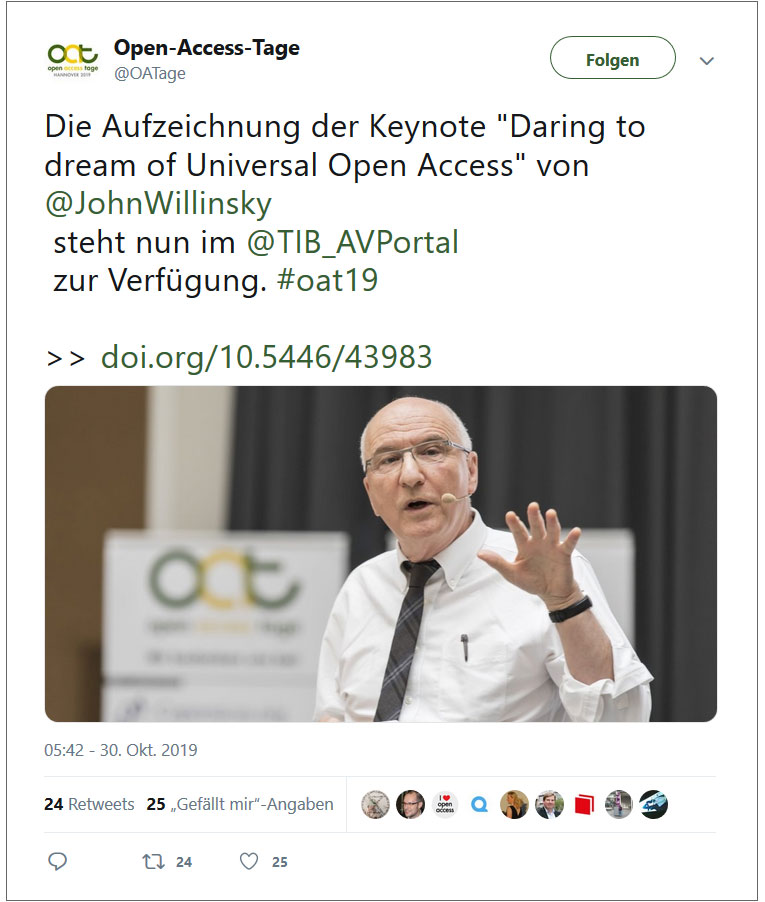
A selection of journals for the Annual Reviews will be transformed into open access journals, provided that all the libraries simply renew their previous subscriptions. The revenues from the subscriptions are used to finance open access journals. Consortium financing includes the initiatives Sponsoring Consortium for Open Access Publishing in Particle Physics
(SCOAP), Fair Open Access Alliance (FOAA) and the Open Library of Humanities (OLH). These models often relate to specific disciplines and are based on consortium payments by organisations, libraries, specialist companies, foundations, and research funding bodies.
In the second presentation in this session “Beyond APC: Criteria for business models” (link in German language, “Jenseits von APC: Kriterien für Geschäftsmodelle”) by Ulrike Kändler and Marco Tullney, criteria for involvement in alternative business models were analysed. In this context, emphasis was placed on the importance of fair open access conditions, cost transparency, clear financing regulations, and participation rights for financing organisations. For libraries, participation in financing models for open access will develop into a key task according to a conclusion of the presentation.
In the third presentation of the session, Jochen Schirrwagen presented the results of an OpenAIRE workshop “How can we sustain open access publishing in a cooperative way?” (link in German language), in which the focus was on the sustainability of alternative business models. The key factors in the success of this are said to include recognition by research funding bodies, the evaluation of quality control by established infrastructures, such as the DOAJ and OA2020, as well as intensive networking of the various initiatives.
(How) can open access transformation be financed?
In session 5, an important topic was, for example, the (financial) impact assessment of open access transformation for authors, organisations and libraries. Is there enough money in the system for OA transformation? Where does money need to be redistributed? What might sustainable transformation look like for all the parties involved? Dr Nina Schönfelder from the National Contact Point Open Access OA2020-DE endeavoured to provide answers to these questions in her presentation “Open access transformation financing for scientific organisations in Germany” (link in German language). In the study presented, calculations were carried out for various research organisations to ascertain whether the acquisitions funding is sufficient and how the acquisitions budget would need to be distributed to allow the APCs of the scientists from the various organisations to be financed without charging the authors too.
These transformation financing calculations were carried out by the National Contact Point Open Access for six different organisations and presented for the University of Bielefeld as an example during the session. The areas investigated include, for example, subscription spending on academic journals by the organisations, the publication output, and the development of the APCs after complete transformation. To determine the publication output, the database of the Competence Centre for Bibliometrics was used as the data source. Based on this data, an analysis was, for example, carried out to determine how many articles were published with an affiliation and/or corresponding author, which type of publication this relates to (journal article, contribution to a collection and so on), in which journals the content was predominantly published, and with which publishers the content was published. Furthermore, conclusions were also drawn regarding the access status of the publication.
A precise overview of the publication portfolio is important to be able to estimate the costs of open access transformation. The annual subscription fees charged for the scientific journals are a known parameter for the organisations. In contrast, calculating the APCs after complete transformation is more complex. To be able to draw reliable conclusions about this, the development of the APCs for various scientific journals was estimated, taking various hypotheses into account. By taking the findings from the publication analysis as the basis, an estimate can be made as to whether the funds previously available were sufficient to finance transformation to an APC-based system (including on a sustainable basis).
The good news is: Under certain conditions, the question of whether there is enough money in the system to finance the APCs incurred by the scientists can be answered with a cautious “yes”. However, this depends to a great extent on how the APCs develop after a journal is “flipped”, on how the publication behaviour of the scientists develops, and also on whether publications continue to be supported by funding bodies. A comprehensive analysis can be found in the recently published “Transformation calculations: resource requirements for open access at selected German universities and research institutes” (link in German language).
Implementing and promoting open educational resources in practice
In addition to business models, open educational resources (OER) and the possible fields of application for these were also discussed this year. Workshop 2, “The moment when… you no longer have to invent your OA course yourself…”, which was well attended, dealt with practical preparatory work for an OA course after giving a brief overview of the theoretical superstructure of OER. Participants worked in groups, researching introductory courses on research-data management, bibliometrics and open access. In addition to best practice examples from various organisations, the participants also had the opportunity to try out and solve the typical stumbling blocks in creating and subsequently using OER at the same time: Where can I find materials? Which materials are suitable for my course? How is the material licensed? Where can I find the CC licence, and what does the specified licence mean for my planned course materials? These are some of the questions that participants were asked to answer, and the devil was often in the detail.
Following this, participants were able to build upon OER knowledge straight away in session 4. Gabriele Fahrenkrog and Alexandra Jobmann demonstrated in their presentation “Supporting UN Agenda 2030 with Open Educational Resources and Open Access” (link in German language), “Mit Open Educational Resources und Open Access die UN Agenda 2030 unterstützen”) how OER and open access support the objectives of the 2030 UN Agenda. OER are suitable resources for eliminating, or at least reducing, inequality in access to education. Thanks to the fundamental principles of reuse and remix in particular, OER promote innovation, fast distribution and creative refinement.
OpenIng (link in German language), the collaborative project between the TU Darmstadt, TU Braunschweig and the University of Stuttgart, demonstrated how this is achieved in the field of engineering. Light was also shed on the question of why OA and OER may not yet be used in the field of engineering. The answers to this were the lack of places to publish, the lack of reputation of OA and OER, and uncertainty about what OA means. Therefore, important factors for promoting this from the perspective of researchers are improvements to the framework conditions of university policies, for example an OA policy, and clear value being placed on openness by university management.
Further Information:
- The presentations of the lectures at the Open Access Days 2019 are now available on Zenodo.
- All posters of the Open Access Days are now published by Zenodo.
- The next Open Access Days will take place from 15. – .17.09.2020 in Bielefeld.
Reference features image: Photo by LUH / Marie-Luise Kolb©
View Comments
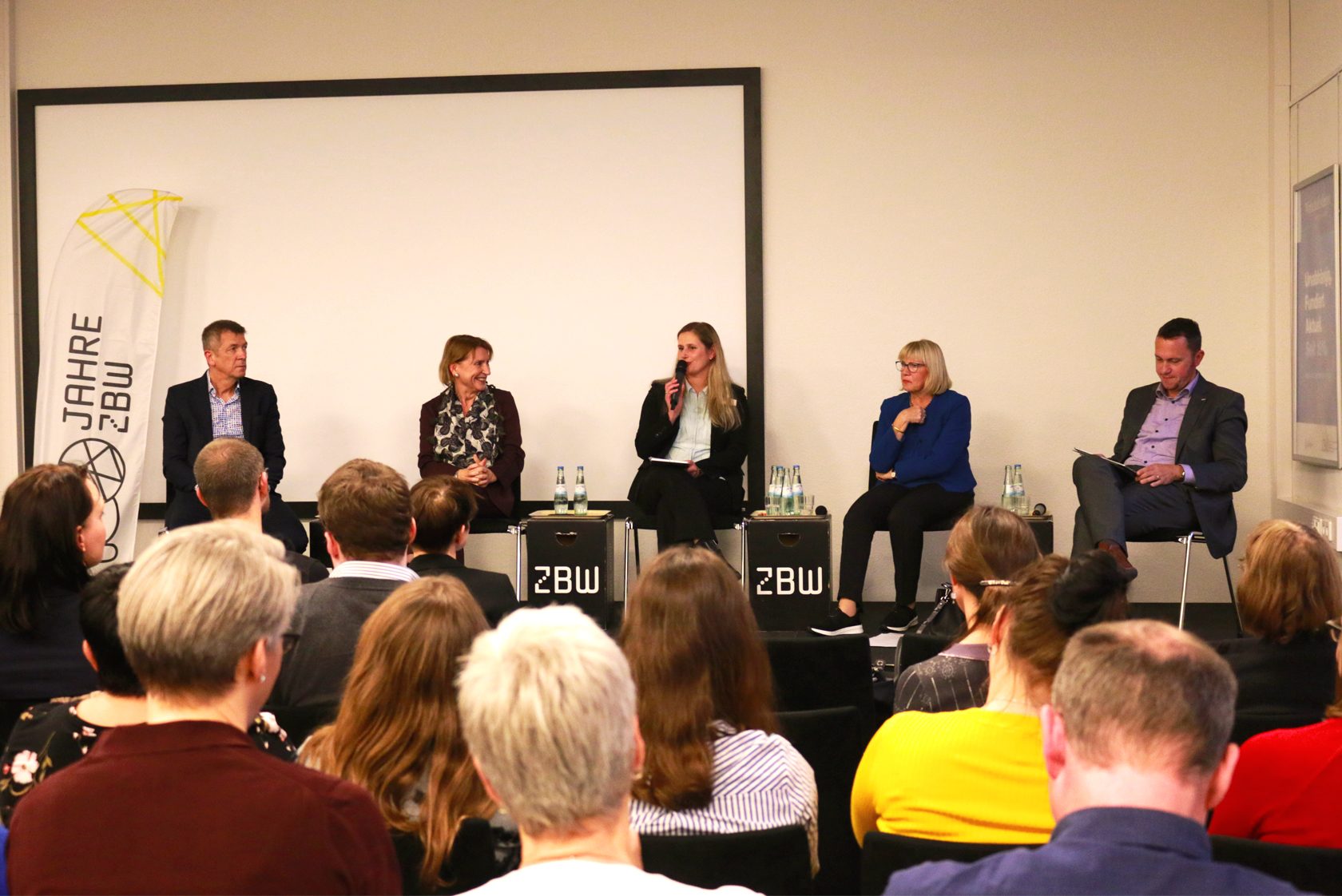
Podium Discussion: Perspectives for “Libraries 2050”
15 years ago, people thought that the future of libraries was rather grim. Now they...

